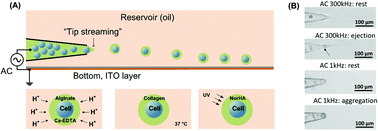Conformal single cell hydrogel coating with electrically induced tip streaming of an AC cone†
Abstract
Encapsulation of single cells in a thin hydrogel provides a more precise control of stem cell niches and better molecular transport. Despite the recent advances in microfluidic technologies to allow encapsulation of single cells, existing methods rely on special crosslinking agents that are pre-coated on the cell surface and subject to the variation of the cell membrane, which limits their widespread adoption. This work reports a high-throughput single-cell encapsulation method based on the “tip streaming” mode of alternating current (AC) electrospray, with encapsulation efficiencies over 80% after tuned centrifugation. Dripping with multiple cells is curtailed due to gating by the sharp conic meniscus of the tip streaming mode that only allows one cell to be ejected at a time. Moreover, the method can be universally applied to both natural and synthetic hydrogels, as well as various cell types, including human multipotent mesenchymal stromal cells (hMSCs). Encapsulated hMSCs maintain good cell viability over an extended culture period and exhibit robust differentiation potential into osteoblasts and adipocytes. Collectively, electrically induced tip streaming enables high-throughput encapsulation of single cells with high efficiency and universality, which is applicable for various applications in cell therapy, pharmacokinetic studies, and regenerative medicine.



 Please wait while we load your content...
Please wait while we load your content...